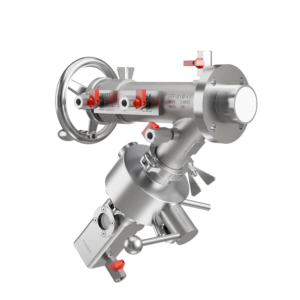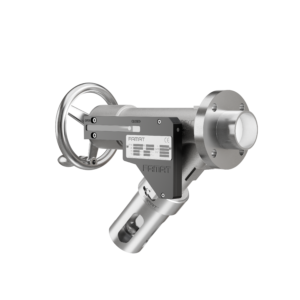The primary butterfly valve purpose is to regulate the flow of materials within large pipe diameters through the quarter-turn rotation of a disc. This introductory guide aims to familiarize you with what a butterfly valve is, how it works, and its design variations. From industrial applications to simple shut-off mechanisms, butterfly valves are integral to many systems.
What is a Butterfly Valve?
Design and Structure
A butterfly valve is a mechanism that regulates the flow of materials within large pipe diameters by the quarter-turn rotation of a disc. This design consists of several key components:
– Valve Body: Fits between the pipe flanges, commonly in flanged, double lug, and wafer types.
– Disc: Functions as a gate to stop or throttle fluid flow. It can be designed to reduce seal wear and operating torque requirements.
– Seat: A strong elastomer or metal anti-leak seal that secures the disc in place for complete shutoff.
– Stem: Connects the disc to the actuation mechanism, transmitting the torque.
– Seals: Ensure a tight seal during operation and isolate the process media from the valve’s internal components.
Principle of Operation
Butterfly valves are classified as quarter-turn valves. The primary butterfly valve purpose is to start, slow, or stop media flow. The disc opens and closes with a low-torque rotation of 90 degrees, always remaining in the flow path, which allows for a drop in pressure. The disc is mounted at the center of the pipe and controlled by a rod and an actuator.
Read more about Pressure relief valve
Types of Butterfly Valves
There are three main types of butterfly valves designed to suit different operations:
- Zero-offset Butterfly Valve: Also known as “concentric” or “rubber seated,” this valve has no offset by the stem and is sealed via interference along the disc edge.
- High-Performance Double Offset Butterfly Valve: Features two offsets that enhance durability and sealing performance, tolerating high pressures and temperatures.
- Triple Offset Butterfly Valve: The most advanced type, designed for high-pressure systems with low emissions and high heat tolerance.
Butterfly Valve Purpose in Various Applications
Common Applications
Butterfly valves are versatile and used across many industries due to their unique mechanisms:
– Food Processing: Requires durable, low-maintenance valves to regulate fluid flow in piping systems. Certified Food Grade Seats are often used.
– Refineries: Utilize high-performance valves for processes involving extreme temperatures and pressures.
– Shut Off Valves: Butterfly valves provide a tight seal, making them ideal for general shut-off purposes in various applications.
– Ship Building: Their durability in saltwater makes them suitable for use in ships, creating watertight shutoffs in tight spaces.
Advantages Over Other Valve Types
Butterfly valves offer significant advantages, especially for dimensions over DN 200:
– Lightweight and Compact: Smaller installation footprint and lower installation costs.
– Low Maintenance: Simple design with few moving parts, reducing maintenance requirements.
– Fast Acting: A 90° rotation of the handle provides quick closure or opening of the valve.
– Cost-Effective: Require less material and are simpler to design and manufacture, making them more economical.
Learn more about sampling valve DN25
Butterfly Valve Parts and Their Functions
Key Components
– Valve Body: Ensures the valve fits between pipe flanges securely.
– Disc: Acts as the gate for fluid flow, designed to minimize wear and operating torque.
– Seat: Prevents leaks and secures the disc in the closed position.
– Stem: Transmits torque from the actuator to the disc.
– Seals: Provide a tight seal and isolate the valve’s internal components.
Actuation Methods
Butterfly valves can be operated manually, semi-manually, or automatically:
– Electric Actuation: Uses an electric actuator for high-precision regulation.
– Pneumatic Actuation: Uses compressed air for high-precision applications.
– Hydraulic Actuation: Suitable for applications requiring large torques.
– Manual Actuation: Operated by handwheels, cranks, or levers, suitable for smaller valves.
Why is it Called a Butterfly Valve?
The name “butterfly valve” is derived from the movement of the disc, which resembles a butterfly’s wing motion. The rod represents the butterfly’s body, and the disc moves up and down with a 90-degree motion, similar to a butterfly’s wings.
Installation and Orientation
Butterfly valves need to be installed with some distance from other parts like pumps and elbows. The standard orientation is with the valve stem vertically aligned, but horizontal installation is also possible. Proper clearance is necessary to ensure the disc does not interfere with nearby components.
Conclusion
Understanding the butterfly valve purpose is crucial for selecting the right valve for your application. Whether for industrial use, food processing, or shipbuilding, the butterfly valve’s versatility, durability, and cost-effectiveness make it an indispensable component in fluid control systems. With various types available to meet specific needs, butterfly valves continue to play a vital role in ensuring efficient and reliable flow regulation across multiple industries.



